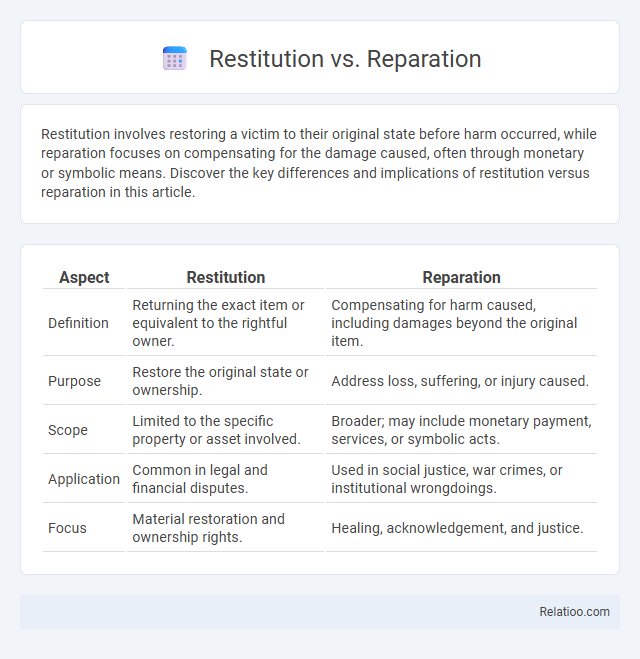Restitution involves restoring a victim to their original state before harm occurred, while reparation focuses on compensating for the damage caused, often through monetary or symbolic means. Discover the key differences and implications of restitution versus reparation in this article.
Table of Comparison
| Aspect | Restitution | Reparation |
|---|---|---|
| Definition | Returning the exact item or equivalent to the rightful owner. | Compensating for harm caused, including damages beyond the original item. |
| Purpose | Restore the original state or ownership. | Address loss, suffering, or injury caused. |
| Scope | Limited to the specific property or asset involved. | Broader; may include monetary payment, services, or symbolic acts. |
| Application | Common in legal and financial disputes. | Used in social justice, war crimes, or institutional wrongdoings. |
| Focus | Material restoration and ownership rights. | Healing, acknowledgement, and justice. |
Introduction to Restitution and Reparation
Restitution involves restoring a victim to their original position by returning lost property or compensating for wrongful gains, emphasizing corrective justice. Reparation focuses on compensating for harm caused by wrongdoing, addressing both material and non-material damages such as emotional distress or loss of reputation. Understanding the distinctions helps you navigate legal remedies effectively, ensuring appropriate measures are sought for recovery and justice.
Defining Restitution: Key Concepts
Restitution involves restoring a victim to their original position before a loss or harm occurred by returning property or its equivalent value. Unlike reparation, which encompasses broader compensation for harm including non-material damages, restitution specifically targets the recovery of specific goods, money, or rights wrongfully taken. Your clear understanding of restitution ensures proper legal recourse for reclaiming assets and enforcing justice in disputes involving wrongful deprivation.
What is Reparation? An Overview
Reparation refers to the act of making amends for a wrong or injury by compensating the victim, often through monetary payment, services, or other forms of restitution. It aims to repair the harm caused by violations such as human rights abuses, war crimes, or injustices, restoring the dignity and rights of affected individuals or communities. Unlike restitution, which focuses on returning the exact property or status, reparation encompasses broader remedies including rehabilitation and guarantees of non-repetition.
Historical Contexts of Restitution and Reparation
Restitution involves restoring stolen or wrongfully taken property to its original owner, commonly applied in historical contexts such as the return of art looted during World War II. Reparation focuses on compensating victims for suffering or loss, often seen in post-conflict scenarios like Germany's payments following World War I under the Treaty of Versailles. Both restitution and reparation address the consequences of injustice, though restitution emphasizes property recovery, while reparation prioritizes monetary or symbolic compensation for harm endured.
Legal Frameworks: Differences and Overlaps
Restitution, reparation, and compensation each operate within distinct legal frameworks addressing harm and remedy, yet they sometimes overlap in scope and application. Restitution primarily aims to restore the injured party to their original position prior to the wrongdoing, emphasizing the return of specific property or benefits unlawfully taken. Reparations extend beyond individual restoration, often encompassing broader remedies mandated by international law to address systemic violations such as human rights abuses, while compensation generally involves monetary payment as a form of redress for loss or injury under civil or criminal law.
Restitution in Practice: Notable Examples
Restitution in practice involves restoring a victim to their original position by returning stolen property or compensating for wrongful loss, as seen in the Holocaust restitution cases where artworks and assets were returned to survivors or their heirs. Another notable example includes post-apartheid South Africa's land restitution programs, which aimed to compensate communities dispossessed during colonial and apartheid eras. These cases highlight restitution's role in addressing historical injustices by legally mandating the return of specific property or equivalent value.
Reparation in Practice: Key Case Studies
Restitution involves restoring a specific asset or property to its rightful owner, while reparation broadly addresses compensation for the harm caused by wrongful acts, often including monetary payments, rehabilitation, or guarantees of non-repetition. In practice, reparation is demonstrated through key case studies such as the South African Truth and Reconciliation Commission, which combined financial compensation with restorative justice measures for apartheid victims, and the German government's reparations to Holocaust survivors, encompassing both direct payments and community rebuilding programs. Your understanding of reparation's practical application deepens by examining these examples, highlighting how legal frameworks translate into tangible support for affected individuals and communities.
Ethical Considerations: Justice and Accountability
Restitution, reparation, and compensation each address ethical considerations related to justice and accountability by aiming to restore victims and acknowledge wrongdoings. Restitution focuses on restoring the original situation before harm occurred, emphasizing corrective justice through direct restoration of property or rights. Reparation and compensation extend to broader forms of redress, including monetary payments and symbolic gestures, prioritizing moral responsibility and societal acknowledgment of harm.
Challenges in Implementing Restitution and Reparation
Challenges in implementing restitution and reparation often stem from complex legal frameworks and the difficulty in accurately quantifying losses or harm endured. You may encounter issues related to establishing clear ownership, collecting sufficient evidence, and addressing the differing expectations of victims and perpetrators. Ensuring timely and fair distribution requires careful coordination among governments, organizations, and affected communities.
Conclusion: Choosing the Right Path Forward
Restitution ensures the return of specific property or its value to the rightful owner, emphasizing legal remedies tied to tangible losses. Reparations involve broader compensation addressing historical injustices and systemic harm, often encompassing financial payments, apologies, or social programs. Choosing the right path requires evaluating the nature of harm, the goals of justice, and the stakeholders involved to balance accountability, healing, and restoration effectively.

Infographic: Restitution vs Reparation
 relatioo.com
relatioo.com